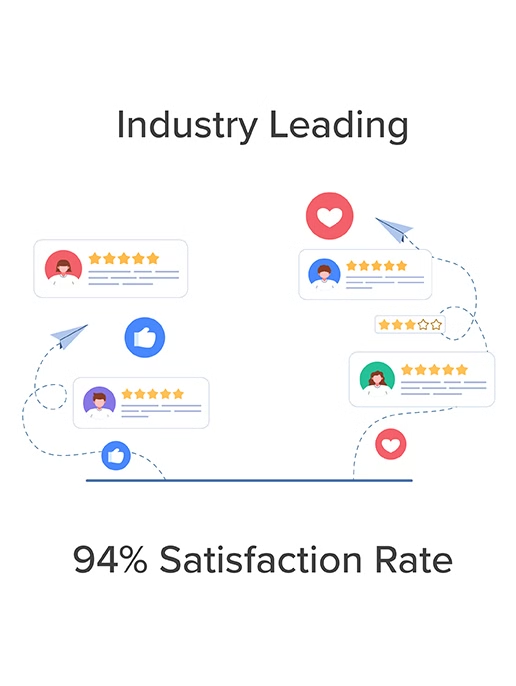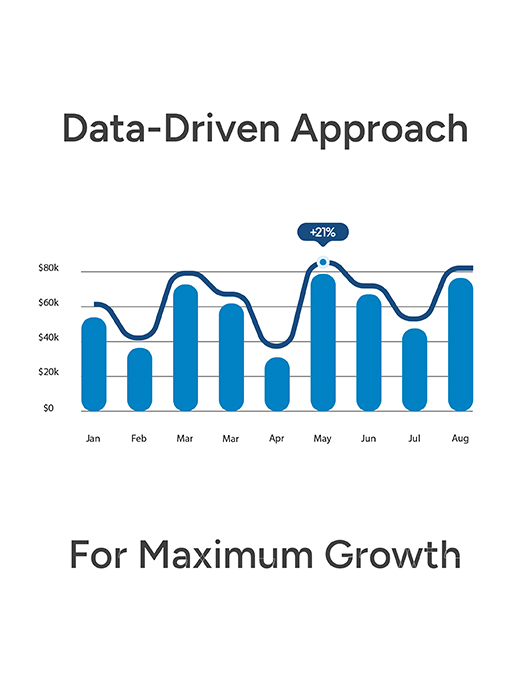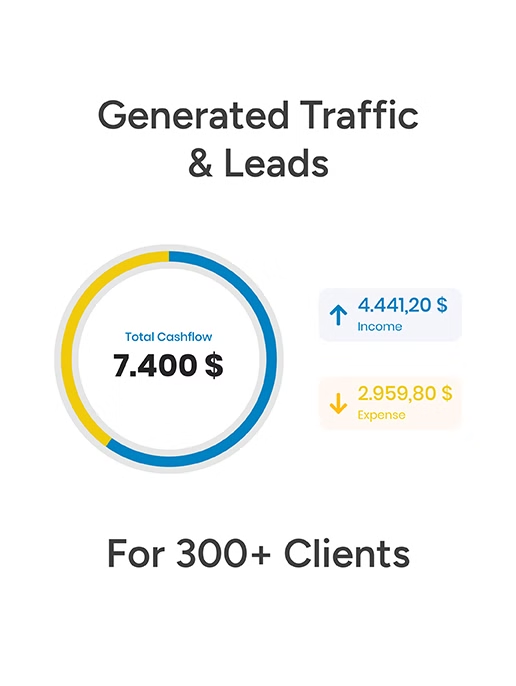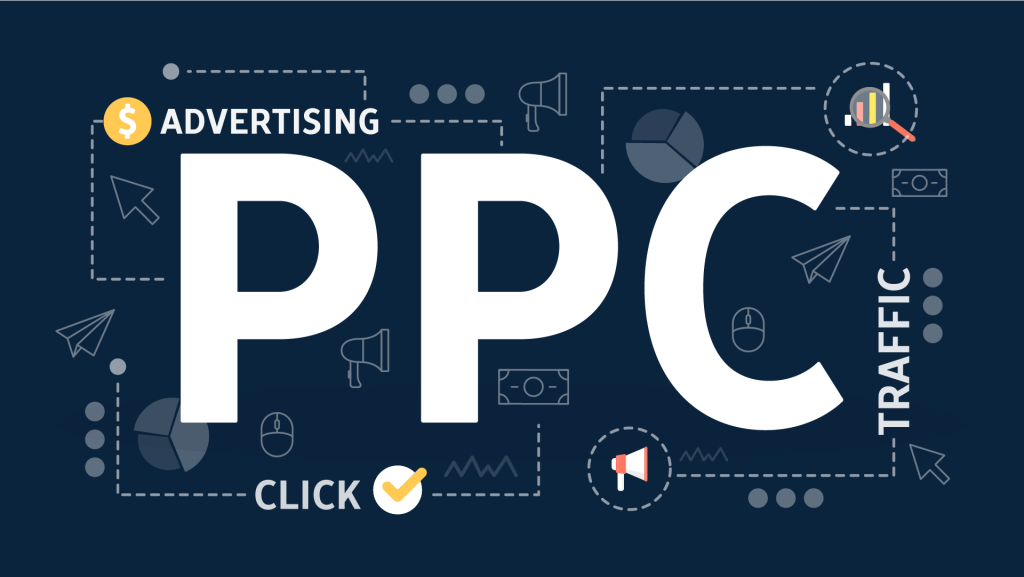


Data-driven strategies are critical to maximizing the revenue from your PPC marketing budget. We create targeted campaigns based on our market research of your industry and the ideal customer persona. Our data-oriented approach means we take strategic decisions to create and optimize PPC campaigns that lead to efficient campaigns.
After launching your initial PPC marketing campaigns, we monitor and optimize your PPC ads to optimize the campaigns for conversions. With our data-driven PPC management services, you can be confident that your advertising budget is being used effectively to grow your business.

As a leading PPC marketing agency, we understand the importance of a comprehensive approach to PPC marketing campaigns. We plan strategically, optimize continuously, and analyze meticulously to ensure your ads connect with potential customers likely to purchase. Focusing on targeting and relevance, we help businesses make the most of their ad budget and maximize the return on investment.
We regularly monitor and optimize your PPC marketing campaigns based on thorough analysis and marketing data. Whether it’s adjusting bids or testing new ad copy, we’re always seeking ways to enhance your campaigns and increase your revenue. With Redefine Web, you can rest easy knowing that our PPC marketing consultants expertly manage and align your campaigns to deliver your desired outcome.
Work with certified PPC specialists to maximize the return on your ad spend. We have the experience and certifications to handle complex PPC campaigns on different platforms. Our PPC consultants aim to deliver the best return on your investment with thorough keyword research, writing ad copy that grabs attention, and ensuring your landing pages are optimized for conversions.
We provide you with detailed reports on how your PPC marketing campaigns are performing with easy-to-understand reports. With our transparent approach, we fine-tune our strategies for your business based on your feedback and business goals. Partner with us to tap into the full power of PPC advertising and see tangible improvements in your marketing results.

We often send out our newsletter with news and great offers. We will never disclose your data to third parties and you can unsubscribe from the newsletter at any time.
Unfortunately, we’re unable to offer free samples. As a retailer, we buy all magazines from their publishers at the regular trade price. However, you could contact the magazine’s publisher directly to ask if they can send you a free copy.
You can create a new account at the end of the order process or on the following page. You can view all of your orders and subscriptions in your customer account. You can also change your addresses and your password.
No, you don’t have to create an account. But there are a few advantages if you create an account.
You never have to enter your billing and shipping address again
Find all of your orders, subscriptions and addresses in your account
Download invoices of your orders
No, we don’t have a physical store location at the moment. We accept only orders through our online shop and we’re shipping all orders with the Swiss Post Service. Please visit our shipping section for more details.
From time to time you will find us at design fairs and popup markets in Switzerland. Subscribe to our newsletter and you’ll receive the latest news.
PPC advertising stands for pay-per-click advertising. It’s a way of using online ads to drive targeted drive to your website based on different criteria. If you’re opening a new business, Google takes time to crawl, index, and rank your website. As search engine optimization takes a long time to take effect, PPC is a highly effective way to put your business in front of people searching for your products or services. It helps you to target your audience accurately, and you can see how well your ads perform. This means you can make changes quickly if you need to. Plus, PPC can help your business stand out, even for searches where it’s hard to rank naturally.
Before launching your PPC campaigns, we work with you to understand your goals. These could be more sales, leads, or brand awareness. Once we know your goals, we find your ideal customers and research the best keywords to reach them.
After conducting comprehensive keyword research, we write compelling ad copies that address your target audiences’ problems and select formats to drive traffic.
After your campaigns have collected enough data, we analyze and optimize your campaigns based on data to maximize your PPC campaigns’ performance.
As part of our PPC management services, we adopt a thorough and strategic method for selecting keywords. We primarily use Google Keyword Planner and SEMrush to select keywords that are closely related to your business and can drive conversions. This includes analyzing the search volume of these terms, evaluating the level of competition, and determining the cost per click for each ad interaction.
We also pay special attention to long-tail keywords, which are longer and more specific phrases that may have lower search volume but can attract more targeted traffic and generate greater interest in your offering. Understanding what potential customers are looking for is essential, so we make sure the keywords we pick match what your campaign is trying to achieve and meet the needs of your audience.
It’s essential to remember that keyword research isn’t a one-time task. We continuously monitor and adjust our list of keywords to ensure they’re still effective and improve your campaigns’ performance.
To ensure your PPC campaigns reach the people most likely to be interested in your business, we first understand your customers. We look at their demographics, interests, and online behavior to create detailed profiles of your ideal customers.
When setting up your campaigns, we use the targeting options provided by advertising platforms to make sure we’re reaching the right people. This includes targeting by location, language, and the devices they use. We also use strategies like contextual targeting, which matches ads to relevant content; behavioral targeting, which focuses on users’ online activity; and retargeting, which reconnects with users who have already shown interest in your products or services.
As your campaigns run, we closely monitor their performance and use what we learn to improve. This ongoing analysis helps us fine-tune who we’re targeting so that your ads constantly reach the people most likely to become your customers.
Our team has the expertise to tailor your campaigns to fit each platform’s strengths and user behaviors. Across different platforms, such as Google, Bing, and Facebook, we’ll ensure your ads effectively communicate with your audience wherever they are. We handle everything from creating ad copy and visuals to adjusting bids and targeting, all while keeping your brand message consistent across platforms. We aim to make a seamless advertising experience that engages your audience and achieves your marketing objectives.
To gauge the success of your PPC campaigns, we closely monitor several essential metrics. These include the click-through rate (CTR), which tells us how often people who see your ad click on it, and the conversion rate, which measures how many clicks turn into desired actions, such as purchases or sign-ups. We also look at the quality score, which reflects the relevance and quality of your ads and keywords, as well as the cost per click (CPC) and cost per acquisition (CPA), which help us understand the financial efficiency of your campaigns. Lastly, we track the return on ad spend (ROAS) to see how much revenue your ads generate compared to their cost. By monitoring these metrics, we can fine-tune your campaigns for better performance and ensure that we use your advertising budget effectively.
Optimizing your PPC campaigns for the best ROI involves several key steps.
We start by refining your targeting options to ensure we reach the right audience. This means selecting the right keywords, demographics, and times of day to display our ads. We also work on your ad copy and the pages on your website that visitors land on after clicking your ads. They need to be relevant and engaging to encourage action.
Another essential strategy is to set the correct bid amounts for your ads. We want your PPC ad campaigns to drive maximum traffic without spending more than necessary. To find the sweet spot, we regularly test different versions of your ads (A/B testing) to see which ones perform better. We also closely monitor how your ads convert visitors into customers and eliminate keywords or ads that aren’t bringing in business.
By tracking all these aspects and tweaking them regularly, we aim to ensure your PPC campaigns are as effective as possible and deliver a solid ROI.
We take a customized approach to budget allocation and bidding in PPC campaigns. We look at what you want to achieve with your business, the typical PPC cost in your industry, or how your PPC ad campaigns performed in the past. This helps us decide how to distribute your budget across different campaigns or ad groups.
We aim to increase your brand’s visibility with minimal costs for bidding strategies. We analyze how competitive different keywords are, consider when your ads will be most effective, and assess how well your ads and website resonate with users (your quality score). Sometimes, we’ll use automated bidding strategies that use machine learning to adjust bids in real-time, ensuring we’re bidding efficiently.
We aim to use your advertising budget effectively so you get the most out of every dollar spent on your PPC campaigns.
We provide ad creative design services tailored for pay-per-click (PPC) campaigns. Our design team collaborates with PPC experts to design ad visuals that catch the eye and encourage viewers to take action. We focus on creating ads that resonate with your brand’s voice and appeal to your potential customers. Whether you need banners for display advertising, creative images for social media, or compelling video content, we deliver creatives to increase engagement and drive conversions.
We approach A/B testing with a structured method, comparing different versions of ads or landing pages to identify which one yields better results. This process relies on careful analysis and meaningful data to ensure our conclusions are solid and actionable. We experiment with various elements, such as ad copy, images, and calls to action, to find the most effective combination. Through ongoing testing and learning, we can fine-tune your PPC campaigns, leading to improved performance and a better return on investment.
To keep your PPC campaigns performing well, we closely monitor their performance by looking at relevant KPIs. This includes click-through rates (CTR), cost per click (CPC), how many conversions you’re getting, and the return on investment (ROI). We use tools that give us detailed analytics to see what’s working and what’s not.
With this data, we can tweak how much we’re bidding for ads, which keywords we focus on, and the ad content to get better results. We often make these adjustments to keep the campaign running smoothly. Besides these quick changes, we also step back regularly to look at the bigger picture, checking for any significant trends or shifts in performance. This might cause more substantial changes in the campaign structure or the target audience. It’s all about ensuring your PPC efforts are as effective as possible.
When we analyze competitors, we examine what similar businesses do with their pay-per-click (PPC) advertising. We examine how they bid on ads, which keywords they’re targeting, and the ad messages they’re putting out there. This gives us a clearer picture of their tactics to attract customers.
By comparing these findings with industry standards, we can see where your campaigns stand and pinpoint areas where you can improve or do things differently. This could mean finding untapped keywords or creating ad messages that stand out more. The goal is to use these insights to build PPC strategies that outperform the competition and set your business apart, helping you capture more attention and, ultimately, more customers.
We consider landing page optimization a core component of our PPC services. When someone clicks on your ad, your brand’s landing page becomes the first substantial interaction, requiring effective design to convert visitors. Our team focuses on improving the elements of your landing page that matter most: the overall relevance to your ad’s message, the clarity of the information presented, and the persuasiveness of the call to action. We also prioritize technical aspects such as page loading speed and mobile responsiveness, ensuring that everyone who lands on the page has a smooth and engaging experience.
Ensuring compliance with advertising rules and regulations is our top priority. We actively monitor the latest requirements for each advertising platform and meticulously review every ad and landing page to ensure they meet these standards before any campaign goes live. Our team proactively monitors regulatory changes and adapts campaigns to meet new guidelines. This attention to detail helps safeguard your business against potential fines or penalties and ensures that your ads reach the right audience without interruptions.
Of course! We prioritize keeping you well-informed about how your pay-per-click (PPC) advertising campaigns are performing. You’ll regularly receive thorough reports that break down essential figures such as click-through rates, conversion rates, and overall campaign effectiveness. These reports will highlight what’s working best and pinpoint areas where we can improve. Plus, we’ll explain any tweaks we’ve made to your campaigns and why we made them. This level of transparency ensures you understand exactly how your investment in PPC is helping you meet your business objectives.
Remarketing and retargeting are key when bringing potential customers back to your site. These strategies focus on reaching out to people who have already shown interest in your products or services by visiting your website but haven’t purchased or taken a desired action yet. We create specialized ads that catch their attention as they browse other websites or scroll through their social media feeds. We customize the ads based on their past interactions with your site, offering them personalized messages and deals that are hard to resist. The goal is to make your brand stand out in their minds, encouraging them to return to your site and complete their transaction, effectively boosting your conversion rates.
When you run pay-per-click (PPC) campaigns, knowing what’s working and what’s not is crucial. That’s where conversion and goal tracking come in. They help you see the actions people take after clicking on your ads. A conversion could be a purchase, a newsletter sign-up, or a download – any critical action valuable to your business.
To set this up, we first decide what you want to track as a conversion. Then, we place small code pieces on your website, often called tracking pixels or tags. These bits of code signal back to your PPC platform whenever a conversion happens. This way, we can tell which ads are leading to results.
This information lets us analyze which parts of your campaigns are performing well. If an ad isn’t leading to conversions, we’ll know it’s time to tweak it or try something new. By monitoring these metrics, we can fine-tune your ads to get you the best return on your investment.
After setting up your PPC campaigns, you might think the hard work is done, but there’s more to it. Ongoing support and management are critical to keep your campaigns running smoothly and meet your goals.
We monitor your campaigns, reviewing your ads’ performance and making adjustments. We analyze the data to see what’s resonating with your audience and where there’s room for improvement.
We might adjust your targeting to reach the right people, tweak your ad copy to make it more compelling, or change your bid strategy to get more for your money. PPC marketing constantly evolves, and we make sure your PPC campaigns can adapt. By staying on top of these changes and managing your campaigns actively, we help you stay competitive and meet your business goals.
We can help you set up and manage pay-per-click (PPC) campaigns for various geographic regions. We customize each campaign to fit the specific area it targets. We pay close attention to the language spoken there, what people are searching for, and any cultural details that might influence the campaign’s success. By focusing on geo-targeting, we ensure that the right people see your ads in each place you want to reach.
We also fine-tune our approach based on the competition and costs in each region, which can vary significantly. By doing this, we help you get the most out of your advertising budget. Our goal is to ensure your ads reach a broad audience and the most relevant one, which can lead to better results for your business.
We’ve got you covered regarding transparency about ad spending and management fees. We believe it’s essential for you to know exactly how your money is being used. That’s why we give you detailed reports that show what you’re spending on ads and what you’re paying for our services to manage them.
You can track every penny, seeing how it’s spent and what you get in return. This way, you can feel confident about your investment in your PPC campaigns. We aim to clarify our value so you can see the benefits of working with us in your advertising efforts.
It’s all about teamwork and communication. We take the time to get to know what you’re aiming for with your overall marketing. Once we understand your goals, we tailor our PPC campaigns to complement what you’re already doing. This means we’ll focus on everything, including ensuring your brand looks and feels the same everywhere, picking the correct times to show your ads, and ensuring the messages in your ads match the rest of your marketing. We see PPC as part of a bigger picture and work hard to ensure it works well with all your other marketing activities.
Absolutely! Ad extensions are a great way to make your ads more powerful and give potential customers more reasons to click. They add extra details and features to your ads, like more links to your website, bullet points highlighting essential offers, or even interactive elements like forms. We’re here to guide you through picking the right extensions that fit your business, like site links for more page options, callouts for special offers, or structured snippets to showcase specific aspects of your products or services. We’ll handle the setup and ongoing management, ensuring these extensions work hard to get you better visibility and more clicks.
